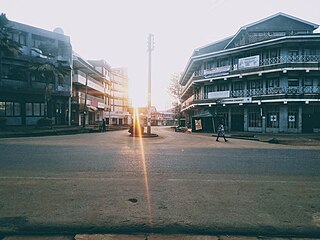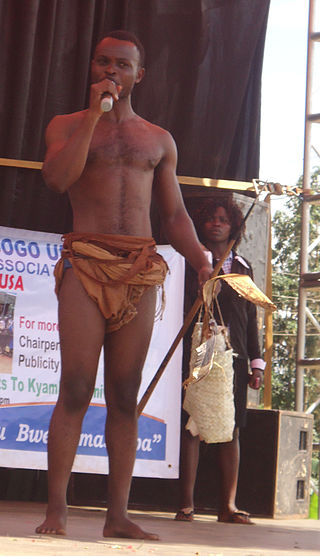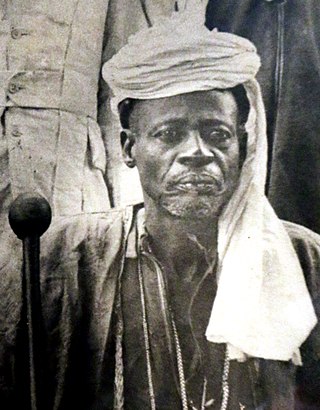
The Luhya are a Bantu people and the second largest ethnic group in Kenya. The Luhya belong to the larger linguistic stock known as the Bantu. The Luhya are located in western Kenya and Uganda. They are divided into 20 culturally and linguistically united clans. Once known as the Kavirondo, multiple small tribes in North Nyanza came together under the new name Baluhya between 1950 and 1960. The Bukusu are the largest Luhya subtribe and account for almost 30% of the entire Luhya population.

Bunyoro, also called Bunyoro-Kitara, is a traditional Bantu kingdom in Western Uganda. It was one of the most powerful kingdoms in Central and East Africa from the 13th century to the 19th century. It is ruled by the King (Omukama) of Bunyoro-Kitara. The current ruler is Solomon Iguru I, the 27th Omukama.

The Bukusu people are one of the 17 Kenyan tribes of the Luhya Bantu people of East Africa residing mainly in the counties of Bungoma and Trans Nzoia. They are the largest tribe of the Luhya nation, with 1,188,963 identifying as Bukusu in the 2019 Kenyan census. They speak the Bukusu dialect.

The Suba (Abasuba) are a heterogeneous Bantu group of people in Kenya with an amalgamation of clans drawn from their main tribes Ganda people, Luhya people, and Soga who speak the Suba language that is closely similar to the Ganda language spare some lexical items borrowed from Luo. Their population is estimated at 157,787, with substantial fluent speakers. They migrated to Kenya from Uganda and settled on the two Lake Victoria islands of Rusinga and Mfangano, others also settled on the mainland areas including Gembe, Gwassi, Kaksingri of Suba South and Migori and are believed to be the last tribe to have settled in Kenya. The immigrants to present-day Subaland trace their ancestry among Ganda people, Luhya people, Soga people, and the Luo people. The evidence supporting this is the fact that some Suba groups speak languages similar to Luganda, Lusoga and the Luhya. The Suba groups tracing ancestry among the Kenyan tribes preceded those groups from Uganda in present-day Subaland and are the numerous and influential ones. Those groups from Uganda are mostly concentrated in Rusinga and Mfangano islands with small pockets of them being found in mainland Kenya. Linguistically, the Suba are highly influenced by the neighbouring Luo, to the point of a language shift having taken place among large portions of the mainland Suba. As a result, their own language has been classified as endangered. Despite this language shift, the Suba have kept a distinct ethnic identity. The Rusinga Festival is held in December of every year as a cultural festival to celebrate and preserve Suba culture and language.
The Oropom were the aboriginal inhabitants of much of Karamoja in Uganda, Mt. Elgon area and West Pokot, Trans Nzoia and Turkana regions in Kenya. Their descendants were largely assimilated into various communities present in their former territories, including the Iteso, Karamojong, Pokot, Turkana and Bukusu. They are or were found in scattered pockets between the Turkwel River, Chemorongit Mountains and Mt. Elgon. One report indicates that they formerly spoke the unclassified Oropom language.

Bungoma is the capital of Bungoma County in Kenya. It was established as a trading centre in the early 20th century. It is located in Kenya's fertile Western region and at the foot of Mount Elgon, Kenya's second-tallest mountain. The town and the surrounding areas boast one of Kenya's highest average rainfalls, making Bungoma one of the nation's most important food baskets.

Busoga is a kingdom and one of four constitutional monarchies in present-day Uganda. The kingdom is a cultural institution which promotes popular participation and unity among the people of the region through development programs to improve their standard of living.

The Gisu people, or Bamasaba people of Elgon, are a Bantu tribe and Bantu-speaking ethnic group of the Masaba people in eastern Uganda, closely related to the Bukusu people of Kenya. Bamasaba live mainly in the Mbale District of Uganda on the slopes of Mount Elgon. The Bagisu are estimated to be about 1,646,904 people making up 4.9% of the total population according to the 2014 National Census of Uganda.

The Masaba people, or Bamasaaba, are a Bantu people inhabiting the eastern Ugandan districts of Sironko, Manafwa, Bududa, Mbale, Namisindwa and Bulambuli. They are closely related to the Bukusu and Luhya of Western Kenya. They are mainly agricultural people, farming coffee, millet, bananas and sorghum on small-holder plots. Maize became popular with the coming of Europeans in the late 1890s.

Busia is a county in the former Western Province of Kenya. It is located directly east of the border town of Busia, Uganda, and borders Lake Victoria to the southwest, Siaya County to the southeast, and Bungoma County and Kakamega County to the east. The county is composed of six sub-counties, and had a population of 893,681 as of the most recent census in 2019.
Mumias is a town in Kakamega County of Kenya. The town has an urban population of 116,358 and is the second largest town in Kakamega County. Mumias was the centre of the Mumias District. The town is linked by road to Kakamega, Busia (west), Bungoma (north), Butere, Luanda, Maseno and Kisumu (south). Two major rivers, River Nzoia and River Lusumu pass close to the town.
Nyamninia is a village in the Gem Location, Yala division of Siaya County, Kenya. Situated approximately 30 miles from Kisumu city, Nyamninia is home to the 100 kilowatts medium wave radio transmitters set up by Voice of Kenya (VoK); now renamed Kenya Broadcastic Corporation (KBC). It was the birthplace of the legendary Gem clan chief, Odera Kang'o who started a rice plantation scheme in the area about one hundred years ago. The Gem chief was responsible for construction the numerous schools in the region before his enforced exile in 1915, to Kampala, Uganda by the British colonialists.

The Maragoli, or Logoli (Ava-Logooli), are now the second-largest ethnic group of the 6 million-strong Luhya nation in Kenya, numbering around 2.1 million, or 15% of the Luhya people according to the last Kenyan census. Their language is called Logoli, Lulogooli, Ululogooli, or Maragoli. The name Maragoli probably emerged later on after interaction of the people with missionaries of the Quaker Church.
Matayos is a settlement in the Busia County of Kenya's former Western Province. Matayos is a small township of about two thousand inhabitants along the B1 road, sixteen kilometres from the Busia border point, and about two kilometres east of the Sio River bridge. Matayos Division, whose seat is at Matayos centre is a very small borough covering the stretch of about twenty-two kilometres from Korinda junction near Busia town at its extreme west-point to the Rakite stream depression near Bumala junction to the east. The division is home to about eighty-thousand people.

Samia speaking people live in Western Kenya and Eastern Uganda. They are composed of several clans and their ancient economic activities include fishing in Lake Victoria and other rivers such as River Sio, crop farming (obulimi), and animal farming (obutuki). The Samia speaking people, as widely known by other tribes, predominantly live in Busia districts and speak a dialect similar to the Luhya tribe in Kenya. However, on the Ugandan side there is a slight variation in the dialect spoken by the Samia of Southern Busia on the fringe of Lake Victoria and those of North Busia district closer to Tororo District. The former speak Olusamia while the latter speak Olugwe. The two dialects are difficult to differentiate by non Samia speaking people but easily discernible by the natives. and in Uganda mainly found inbusia and Namayingo district.

Nabongo Mumia Shiundu was a prince who became 17th King of the Wanga Kingdom, a pre-colonial kingdom in Kenya and Uganda prominent for being a centralised, highly organised kingdom and the most advanced form of government in terms of politics, economy and military in pre-colonial Kenya. He later became paramount chief of an expansive region of Kenya and Uganda at the beginning of British imposition of colonial rule in East Africa.
Matayos constituency is a sub-county of Busia County in the western province of Kenya. It is one of seven constituencies in Busia County. The constituency is along the Kisumu-Busia Highway and is mainly occupied by the Bakhayo, a sub-clan of the Luhya people. Being part of the lucrative investment grounds, the settlers in the region depend mainly on livestock and grains as their primary source of income. Additional contributions to the local economy include fishing and other agricultural activities. Matayos is the home of Amos Wako, the longest serving Attorney General in Kenya. The area MP is Geoffrey Makokha Odanga of the ODM party.

The Wanga kingdom is a Bantu kingdom within Kenya, consisting of the Wanga (Abawanga) tribe of the Luhya people (Abaluyia). At its peak the kingdom covered an expansive area from Jinja in west to Naivasha in the East African Rift. The Wanga kingdom was a significant African empire and the most organized structure of government in pre-colonial Kenya politically, economically, and militarily.

The Sabaot are one of the nine sub-tribes of the Kalenjin of Kenya and Uganda. The Sabaot in turn are divided into six sub-tribes largely identified by their dialects. These dialects of the Sabaot language are the Pok, Somek, Mosop, Koony, Bong'omek and Sabiny. Being resident around Mount Elgon, the original homeland of most Kalenjin, the Sabaot are seen as the keepers of the authentic Kalenjin tradition. They and the area they inhabit are often referred to as Kapkugo by other Kalenjin.
The Iloikop wars were a series of wars between the Maasai and a community referred to as Kwavi and later between Maasai and alliance of reformed Kwavi communities. These were pastoral communities that occupied large tracts of East Africa's savannas during the late 18th and 19th centuries. These wars occurred between c.1830 and 1880.











